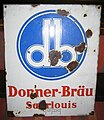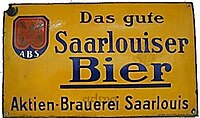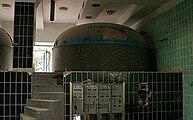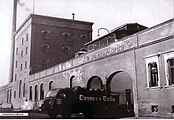Thunderbrew
The Thunderbrew AG Saarlouis , colloquially referred to as thunder brewery, was from 1898 to 1978 a brewery in Saarlouis . There she brewed different types of beer in the city center, often reduced to the catchphrase Donnerbier in collectors' forums , the export of which made Saarlouis known far beyond national borders.
In addition, the Donner brewery was the only brewery in the Saarlouis area that was able to continue operating after 1908. In 2009 a new park will be named "DonnerPark" after the brewery or the hall name. In both cases, the term thunder derives from the source of thunder in Wallerfangen, from which the brewery has drawn its water since the first takeover. As a result of the renaming of the city of Saarlouis, the company location was called Saarlouis 1 (1907–1936), Saarlautern 1 (1936–1945) and Saarlouis (1946 to today), which is reflected in the respective company names.
Company history
In the founding phase, the directors were Oskar Tobias, with the takeover by the Werger Brewery Wilhelm Siegfried, and since 1938 Dr. Otto Schmidt and after his death in 1944 his wife Else Schmidt-Klett. Dr. Otto Schmidt and Else Schmidt-Klett were also owners of the castle brewery in Neunkirchen.
- 1898 Founded as Actienbrauerei Saarlouis , abbreviation ABS, whereby the name was adapted to the general change from shares to shares in Aktien-Brauerei Saarlouis. This became the Donnerbräu AG Saarlouis (1929).
The years 1918 to 1936, i.e. the first Saar Statute, are characterized by the takeover of Donnerbräu by the Wormser Werger Brewery and the elimination of the right-hand sales areas. With the occupation of the Saar by France , the existing sales markets were expanded and the beers of the brewery also reached the French colonies.
- 1936 Renaming to Donnerbräu-AG Saarlautern
- 1945 renamed to Donnerbräu AG Saarlouis after the Second World War
In 1954 the name was changed to Donnerbräu GmbH Saarlouis , whose management was first carried out by Peter Becker, then by Niko Becker, as managing director. The brothers belonged to the third generation of the St. Ingbert family business , according to the festival magazine "75 Jahre Becker" from the brewery Gebrüder Becker . The Thunder Brewery was only kept open by the Becker Brewery for the 25-year blocking period negotiated with Ms. Else Schmidt-Klett. In 1978/79 production was relocated to St. Ingbert. The Becker brewery located there (1877 to 1998) also had to stop production 20 years later and was taken over by the Karlsberg brewery from Homburg . In Saarlouis, the demolition of the chimney in 1986, the demolition of the production facilities in 1992 and finally in 2009 with the demolition of the brewery yard and the last remains of the warehouse in the Wallerfangerstraße - Neue-Brauerei-Straße area left the last remains of the brewery apart from the so-called Green Villa the former brewery administration, removed. The brewhouse stood until 2009, otherwise, according to Development plan of the city of Saarlouis, the nearby multi-storey houses could not have been built.
The DonnerPark, a residential complex, has been built on the former brewery site since 2009.
Acquisitions
The 80-year history of the brewery is not only characterized by historical events but also by two takeovers. Founded in 1898 as a company from Saarlouis, the first takeover took place in 1922 by the Werger brewery in Worms , which was looking for a way to reopen the former sales markets on the left bank of the Rhine. The second takeover took place in 1954 by the St. Ingberter Becker Brewery 6, which eliminated local competition.
On closer inspection, the time when Otto Schmidt was in charge of Donnerbräu from 1938 and later by his wife Else Schmidt-Klett can also be seen as a takeover, since both were owners of the Neunkirchen Castle Brewery . Otto Schmidt also worked as a lawyer in Vienna until 1936 and only became head of the brewery after the Saarland was re-annexed to the German Empire .
Types of beer
The Saarlouis Aktienbrauerei, also known as Donnerbräu, has, like most breweries, produced various beers in the course of its company's history. The best-known brands included the ABS Bockbier (also: donner Bock) , the donner Export , the donner Neues Pilsener (also known as donnerquell Pilsner) as well as the donner Spezial, which was also called Saarlouiser Neger and the donner Doppelbock Export. The Saartalbräu, which was brewed in the Actienbrauerei Saarlouis from 1900 to 1923, is also worth mentioning. The green bottles were labeled "A / c | k / tienbrauerei X Saarlouis", the white porcelain stoppers were labeled "Saartalbräu" in red.
During the First and Second World Wars, the Donnerbrauerei also produced thin beer , which of course is not an independent brand, as well as various non-alcoholic malt beverages after 1954.
After the Donner brewery was taken over by the Becker St. Ingbert brewery , Vitamalz has been produced in the Saarlouis Becker branch since the end of the 60s . However, the licensee was the St. Ingberter Becker brewery.
The use of the term negro in the brand name is unusual and probably based on the Walsheim negro . Because in the southern German dialect it means a Colabier. Since Walsheim is located in the former Bavarian part of the Saarland, the formation of the term is understandable. Saarlouis, the location of Thunderbrew, but is part of the former Prussian Saar region, and there seems to use unusual because the dialect local beer as a cola Gespritzes referred. The Saarlouis negro was shown to be sweetened with a sweetener as a beer.
The lunch beer that was produced in the db in the 1960s was a slightly fermented beer that was prevented from fermenting further by filtration and pasteurization and contained around 0.5% alcohol. Since it was not an economic success, according to contemporary witnesses, the still existing bottle and barrel contents were added to the normal beer during filtration in order to keep the loss within limits.
Output numbers
The output figures can be used for an objective consideration of the potency of a brewery. The Saarlouis share brewery produced around 18,000 hectoliters (hl) around 1911 and increased this to 27,000 hl by 1914. The continuous increase, around 1920 to 40,000 hl, 1956/57 to 72,270 hl, shouldn't hide the fact that other breweries, such as the Becker Brewery, the Walsheimer Brewery or the Karlsberg Brewery, emitted well over 100,000 hl per annum in the same period. The steadily growing number of hectoliters resulted from the fact that the joint stock brewery still had a lot to catch up on due to its late founding.
Even in a comparison of the output figures with the direct competition, the Aktienbrauerei Merzig, one can see on the one hand the need to catch up with Donnerbräu / ABS and at the same time identify important sections for the Saar area.
In the year of the decline of the stock exchange, i.e. the business year 1929 to 1930, the Donnerbräu produced 47,654 hl, the ABM 85,849 hl. By the time of the first Saar Statute, the output figures at both breweries fell to 32,964 and 45,147 hl, respectively. From then on, the output figures of the two breweries recovered again, whereby they were almost identical, which, however, meant for the Aktienbrauerei Merzig that it produced around 40,000 hl less than in 1929. This fact is supported by several local researchers against the reprisals of the - by Jewish businessmen founded - Aktienbrauerei Merzig exposed was attributed.
The evacuation of the Saar area can also be seen from the emissions: in the business year 1944 to 1945 the Donnerbräu emitted 15,650 hl, the Merzig brewery 8,785 hl. After the Second World War, the brewery recovered only slowly, with the Merzig stock brewery achieving the higher output, but without even being within the range of e.g. B. the Becker Brewery or the Karlsberg Brewery. In 1954, i.e. in the year of the takeover (financial year 1953 to 1954) and the name change from Donnerbräu AG Saarlouis to Donnerbräu GmbH, it achieved 41,926 hl, an output that corresponded to the values of the years 1924–1930 and 1940–44.
In the transition from the business year 1937/38 to 1938/39 there was a significant upswing in Donnerbräu from 38,150 to 48,227 hl. Local researcher Dr. Neumann took over the management of Donnerbräu by Dr. jur. Otto Schmidt, who also owned the Neunkirchen Castle Brewery . Schmidt was classified as loyal to the line because of his military career in the First World War. Therefore, he was not exposed to the difficulties on the part of the National Socialists , under which the Eichbaum-Werger brewery had suffered as the previous owner of the Donnerbräu, which finally forced the Walsheim brewery to close and the Jewish joint stock brewery Merzig made normal sales and production more difficult . It was precisely these anti-Jewish measures that provided a real upswing in the Donnerbrauerei, as the oldest competitors were sometimes heavily burdened.
Schmidt-Klett era and its effects
The couple Dr. Schmidt-Klett bequeathed their private property to the cities of Neunkirchen and Saarlouis , which was determined by various auctions after the death of Ms. Schmidt-Klett in Stuttgart in 1954 at around 3.2 million DM. The condition was to invest the money long-term and primarily for use by war victims and veterans. This created the Schmidt-Klett Foundation in Neunkirchen. In Saarlouis, which, as the so-called Saarlautern Citadel, had been hit much harder by the Second World War, the financial means were used to finance the urgently needed old people's home, which can be seen on the plaque in the forecourt.
The affinity of the Schmidt-Klett couple to the two cities consisted of the ownership of the castle brewery in Neunkirchen and the Donnerbräu in Saarlouis.
gallery
- db signs and photos
swell
- ↑ http://donnerbraeu.rodena.de/donner.bier/Donnerbraeu_1WK_und_Weimarer_Republik , last accessed on January 8, 2010
- ↑ a b c d e Andreas Neumann: All about the Donnerbräu Saarlouis - project volume November 2009: donnerbraeu.rodena.de . Books on Demand, 2009, ISBN 978-3-8391-4107-6 . , 2nd Edition. Data, etc. a. Scans and pictures, also available online: Donner Brewery project website Rodena
- ↑ a b c Andreas Neumann: All about the Donnerbrauerei Saarlouis - Project volume November 2010 - With pictures and texts by Manfred Wilhelm - donnerbraeu.rodena.de . Books on Demand, 2010, ISBN 978-3-8423-4004-6 . , 1st edition. Pages: 17 u. 18; 36; 57.
- ↑ cf. http://donnerbraeu.rodena.de/donner.bier/donner-bier-DOPPELBOCK , last accessed on January 23, 2010
- ↑ http://donnerbraeu.rodena.de/donner.bier/Biersorten_der_Donnerbraeu , last accessed on January 12, 2010. see also: Stadtarchiv St. Ingbert, Beckerakten.
- ↑ Andreas Neumann: All about Donnerbräu Saarlouis - project volume November 2009: donnerbraeu.rodena.de . Books on Demand, 2009, ISBN 978-3-8391-4107-6 . , 2nd Edition. Page 197 a. 198; Note there: data based on the Saarland Brewery Association partially replaced by information from Claus Hoffmann-Güth. Data published on http://donnerbraeu.rodena.de/donner.bier/Ausstosszahlen_der_Donnerbraeu for free use by the author stating name or book.
- ^ Lecture "Aktiengesellschaft Neunkirchen / Merzig / Saarlouis and Becker Brewery"; November 3, 2009; Location: museum. academia wadegotia. Transcript held there.
- ↑ http://donnerbraeu.rodena.de/donner.bier/Schmidt , last accessed on January 10, 2010
- ↑ see also: http://donnerbraeu.rodena.de/donner.bier/Eichbaum-Werger , last accessed on January 10, 2010
- ↑ cf. http://donnerbraeu.rodena.de/donner.bier/Stiftung_Schmidt_Klett , last accessed on January 17, 2010
literature
- Andreas Neumann: All about Donnerbräu Saarlouis - Project volume November 2009: donnerbraeu.rodena.de . Books on Demand, 2009, ISBN 978-3-8391-4107-6 . , 1st and 2nd edition.
- Andreas Neumann: All about the Donnerbrauerei Saarlouis - Project volume November 2010 - With pictures and texts by Manfred Wilhelm - donnerbraeu.rodena.de . Books on Demand, 2010, ISBN 978-3-8423-4004-6 . , 1st edition.
- Claus Hoffmann-Güth: The development of the Karlsberg brewery, 1918-1992: from a simple medium- sized company to a group of companies in the mirror of regional history and in comparison to the development of the industry , Verlag SDV, 1998, 413 pages, ISBN 3930843323 .









